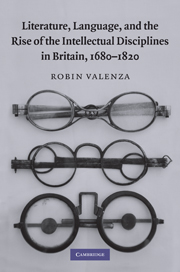Book contents
- Frontmatter
- Contents
- List of Figures
- Acknowledgments
- 1 The Economies of Knowledge
- 2 The Learned and Conversable Worlds
- 3 Physics and its Audiences
- 4 Philosophy's Place Between Science and Literature
- 5 Poetry Among the Intellectual Disciplines
- Coda: Common Sense and Common Language
- Notes
- Works Cited
- Index
3 - Physics and its Audiences
Published online by Cambridge University Press: 14 December 2009
- Frontmatter
- Contents
- List of Figures
- Acknowledgments
- 1 The Economies of Knowledge
- 2 The Learned and Conversable Worlds
- 3 Physics and its Audiences
- 4 Philosophy's Place Between Science and Literature
- 5 Poetry Among the Intellectual Disciplines
- Coda: Common Sense and Common Language
- Notes
- Works Cited
- Index
Summary
Nature and Nature's Laws lay hid in Night:
God said, Let Newton be! And all was Light.
– Alexander Pope, “Epitaph for Sir Isaac Newton” (c.1730)When Alexander Pope turned his pen to writing an epitaph for Isaac Newton, his task was formidable: How does one capture the blazing glory of the first man knighted in England for scientific discovery? How does one account in two short lines for the apotheosis of the man who wrote the charter for modern science? True to form, Pope succeeded admirably, capturing in his eulogistic couplet the effects of both Newton's astronomical advances and his optical discoveries, as well as their perceived effect on the world at large. By his death in 1727, Newton was in the eighteenth-century imagination a divine figure indeed, earning widespread poetic praise atop his longstanding accolades from the scientific world. The reigning metaphor of the enlightenment – the bringing of light into the darkest recesses of nature and the human mind – was given literal form by Newton's writings on light and color.
But Newton's ability to illume nature and nature's laws was not so easily perceived in 1687, when he published his first major work, Philosophiae Naturalis Principia Mathematica (Mathematical Principles of Natural Philosophy). The eventual, startling popularity of Newtonianism in England and abroad belies how difficult, technical, and unreadable Newton's own published work often was.
- Type
- Chapter
- Information
- Literature, Language, and the Rise of the Intellectual Disciplines in Britain, 1680–1820 , pp. 54 - 91Publisher: Cambridge University PressPrint publication year: 2009



